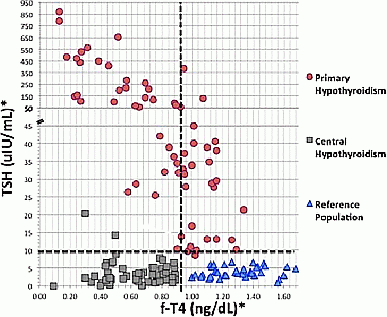ESPE2015 Poster Category 2 Thyroid (30 abstracts)
Central or Primary Hypothyroidism? How to Differentiate in Patients with Low T4 but Mildly Elevated TSH Levels
Serap Turan , Ziya Gurbanov , Serpil Bas , Saygin Abali , Zeynep Atay & Abdullah Bereket
Department of Pediatric Endocrinology, Marmara University. Istanbul, Turkey
Background: Central hypothyroidism (CH) is caused by TSH and/or TRH deficiency leading to hypothyroxinemia with low, normal or mildly elevated TSH levels. Differentiation of CH with mildly elevated TSH levels from primary hypothyroidism (PH) can be difficult. However, this differentiation has important clinical implications (i.e. cortisol replacement before L-thyroxine).
Objective and hypotheses: In this study, we constructed a nomogram allowing us evaluating TSH levels relative to fT4 levels in CH and PH, thus providing more objective criteria for the diagnosis.
Method: 63 patients with congenital PH (24 thyroid dysgenesis, 39 with eutopic thyroid) and 55 patients with CH having multiple pituitary hormone deficiencies (33 congenital hypopituitarism, 22 hypopituitarism secondary to hypothalamo-pituitary tumor and/or cranial radiation) and 63 healthy controls included in the study. TSH and fT4 levels before initiation of L-thyroxine treatment were evaluated in the patients.
Results: In CH, he mean TSH was 3.6±3.5 uIU/ml (median: 2.8, range: 0.006–20.3) with a mean fT4 of 0.61±0.2 ng/dl (median: 0.66, range: 0.009–0.91). In PH group, mean TSH was 148±205 uIU/ml (median: 40, range: 8.65–867) with a mean fT4 of 0.78±0.3 ng/dl (median: 0.89, range: 0.12–1.34). TSH versus fT4 nomogram is shown in Figure. Analyses revealed that in a patient with hypothyroxinemia, a TSH cut off of <10 uIU/ml is discriminatory for CH with a sensitivity and specificity of 96% (95% CI: 86%–99%) and 100% (95% CI: 88%–100%) respectively. Similarly, a TSH cut off of >25 uIU/ml is discriminatory for PH with a sensitivity and specificity of 97% (95% CI: 84%–99%) and 100% (95% CI: 91%–100%) respectively.There were two patients in CH group with TSH levels 20.3 and 14.3 uIU/ml who also had ACTH and GH deficiencies and, pituitary hypoplasia and pituitary hypoplasia with ectopic neurohypophysis on MRI, respectively. There was one patient with PH with TSH<25 uIU/ml.
Conclusion: When fT4 is low, TSH cut-off <10 uIU/ml is highly sensitive for diagnosis of CH, however TSH levels could be up to 20 uIU/mL in proven CH cases. Nomogram provided in this study could be useful for discrimination in uncertain cases.

Figure 1 TSH and fT4 levels in reference population, patients with primary and central hypothyroidism. *fT4 and TSH were studied with ECLIA method with reference ranges of 0.93–1.7 ng/dl and 0.27–4.2 ulU/ml respectively
 }
}



